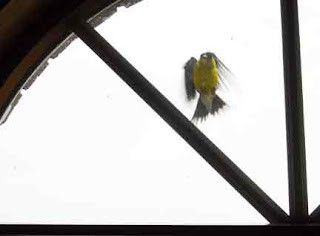We get invaded by a variety of little beasts around our home each summer. It's amazing what you can find in your own yard. This praying mantis was outside our back door yesterday. Also called a Carolina mantid, Stagmomantis carolina (08/09/07).
This praying mantis was outside our back door yesterday. Also called a Carolina mantid, Stagmomantis carolina (08/09/07).
"Take me to your leader"
 She has some wicked legs!
She has some wicked legs! Grasshopper or locust? It turns out, that they are the same thing. The short-horned grasshopper, Family Acrididae, is also known as a locust.
Grasshopper or locust? It turns out, that they are the same thing. The short-horned grasshopper, Family Acrididae, is also known as a locust. Not to be confused with the long-horned grasshopper, Family Tettigoniidae. Katydids are a long-horned grasshopper, although this is not a katydid. (9/14/07)
Not to be confused with the long-horned grasshopper, Family Tettigoniidae. Katydids are a long-horned grasshopper, although this is not a katydid. (9/14/07) A nest of Cicada Killers, Sphecius Sp., lived under the side deck throughout July and August of 2006. They returned this year. (7/21/07)
A nest of Cicada Killers, Sphecius Sp., lived under the side deck throughout July and August of 2006. They returned this year. (7/21/07) They look like huge wasps, which they are, but are relatively harmless to people. All they really want to do is, well... kill cicadas.
They look like huge wasps, which they are, but are relatively harmless to people. All they really want to do is, well... kill cicadas.Possibly a Dog Day Cicada, (Cicadidae family, superfamily Cicadoidea, suborder Auchenorrhyncha).

In August, a group of Funnel Weaver Spiders, Agelenidae Sp., took up housekeeping in the roses, daylilies and elsewhere.


A few Garden Spiders, Argiope Aurantia, also moved in during August and September.
 A jewelled web.
A jewelled web.


 It must have worked, because the male is still hanging around into mid-October. (10/14/06)
It must have worked, because the male is still hanging around into mid-October. (10/14/06) This spring we had a nest of baby bunnies, which usually stayed well hidden in the Russian sage and pampas grass. I did happen to get a shot of one of the baby American robins, Turdus migratorius, as it was learning to fly and explore its new surroundings. (5/28/07)
This spring we had a nest of baby bunnies, which usually stayed well hidden in the Russian sage and pampas grass. I did happen to get a shot of one of the baby American robins, Turdus migratorius, as it was learning to fly and explore its new surroundings. (5/28/07) For the past two weeks, a goldfinch, Cardualis tristis, has been coming to my office window, sometimes pecking at the glass and flapping its wings,
For the past two weeks, a goldfinch, Cardualis tristis, has been coming to my office window, sometimes pecking at the glass and flapping its wings, I'm not sure if it wants inside, or if it thinks it has found its mate in the reflection. (7/26/07) By the first week of August, it was no longer making it's daily visits.
I'm not sure if it wants inside, or if it thinks it has found its mate in the reflection. (7/26/07) By the first week of August, it was no longer making it's daily visits.
A female Red Velvet Ant, Dasymutilla aureola pacifica, was wandering around the back foundation today (7/29/07). I saw a male flying around earlier, as well. Males fly - females walk. They aren't really ants at all, but actually a wasp, also known as a "cow killer" due to it's painful sting.

We've also had several Eastern American Toads, Bufo americanus, take up residence around the yard. They can stay, as long as they keep eating mosquitos and don't come out of their hole when I'm mowing. (7/29/07)
 The webworm moth, Hyphantria cunea (Drury), found our oak tree this summer. The larvae don't generally kill trees, but they sure can ugly them up. (08/04/07)
The webworm moth, Hyphantria cunea (Drury), found our oak tree this summer. The larvae don't generally kill trees, but they sure can ugly them up. (08/04/07)
And what would summer be without Monarch butterflies, Danaus plexippus, feeding on nectar from... a Butterfly Bush. (7/29/07)
 A tiger swallowtail Papilio glaucus, also enjoying the Butterfly Bush. (8/19/07).
A tiger swallowtail Papilio glaucus, also enjoying the Butterfly Bush. (8/19/07).



No comments:
Post a Comment